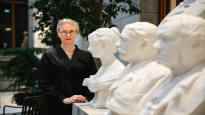STOCKHOLM The Swedish National Museum, or Nationalmuseum, is in Stockholm on the parade ground: on the opposite bank is the Royal Palace and a stone’s throw away is the modern art museum, or the state-owned Moderna Museet.
The Swedish National Museum is a large and old art and design museum, even by European standards. Its collections include 700,000 works. Many of the works were originally acquired by royalty.
In the years 2013–2018, the museum building was closed due to renovations, and then, among other things, works by a beloved Swedish artist were returned Carl Larsson large murals in their glory in the entrance hall.
After the renovation, the annual number of visitors rose to one million. Among Stockholm’s attractions, only the Vasa ship and Skansen can do better.
During the worst corona years, the museum was closed twice. Now the visitors have returned, but the audience records remain unbeaten. The reason is the new government’s decision to return admission fees to state museums.
The government does not want free museum visits for foreigners
The new government will cut the culture budget by ten percent, and the final amount for 2023 will be around 900 million euros. By returning admission fees to state museums, it is estimated that a saving of around nine million euros will be generated per year.
In the case of the National Museum, no index increases are made for state grants, and price increases, i.e. inflation, are not taken into account. This year the museum received about 23 million euros from the state, in next year’s budget the figure is 21.8.
The government has justified the return of entrance fees, among other things, by the fact that it is not necessary to finance museum visits by foreign tourists with Swedish tax funds.
On a weekday in December, the National Museum is visited Shannon Evans From Sheffield, UK.
– If there had been an entrance fee here, then maybe I wouldn’t have come, maybe I would have gone to a Christmas market.
Evans had heard about the entrance fees coming into force at the turn of the year, and therefore decided to come to the museum on this particular trip to Sweden. For him, a voluntary donation would have been a better option than admission fees.
Families save on culture
At the same time, a Stockholmer is also visiting the museum Ola Hässler.
– I haven’t been here since the renovation and today is the last day of my paternity leave, so I decided to do something nice.
Hässler says he understands that in these times the culture budget is also being cut.
For him, the entrance fee will not be a threshold issue in the future, but he believes that spontaneous visits to the museum will decrease.
That happens, for example To Lina Burman and To Geir Yttervik.
– We decided to come now, while it’s still free, Lina Burman says.
He should not be charged entrance fees.
– Now that these are still such hard times, culture is certainly the first thing that many people pinch, Burman continues.
The general director of the Swedish National Museum Susanna Pettersson says that admission fees will certainly cut the number of visitors, but also the exhibition activities of museums.
– The number of visitors is guaranteed to decrease, and it directly affects the kind of operational opportunities we have.
Due to the cuts, the National Museum has already canceled two exhibitions planned for next year. Both the Romance exhibition and the exhibition related to car design will be moved to next year.
In addition, the museum will be closed not only on Mondays but also on Tuesdays.
According to Pettersson, the new culture minister is from a moderate coalition Parisa Liljestrand has justified the charging of admission fees, among other things, by the fact that this way museums can make exhibitions of an even higher standard.
– That is not true. These two things don’t go together.
Pettersson is also concerned about crisis preparedness
Susanna Pettersson has a PhD and has had a long career in various museums in Finland.
According to him, in Finland, the awareness of the possibility of a crisis or war has always been present, but in Sweden, the situation has only now become apparent, which can be heard in very everyday discussions in art circles.
According to Petterson, the views of the Finnish and Estonian colleagues are close to each other, unlike the Swedes.
– It is of course due to this long history.
Pettersson says that the national museum has made its own contingency plans and the staff knows in what order the valuable works will be saved in the event of a threat.
But according to Pettersson, only now, after Russia’s attack, did Sweden begin to discuss the protection of national cultural heritage more broadly.
– This is an extremely important question for the new government. There is a lot to do in terms of the safety of cultural heritage and raising the level of preparedness.
– At the moment, Swedish legislation does not support us getting help from, for example, the defense forces when a war breaks out. Cultural heritage sites have not been mentioned in the legislation to the extent that this would be possible.
The fate of the museum’s Rembrandts does not keep the museum director awake at night, as they can be saved by the efforts of their own staff. But the museum’s own staff is not enough for extensive rescue operations.
What thoughts does the news evoke in you? You can discuss the topic until 23:00 on December 21.
